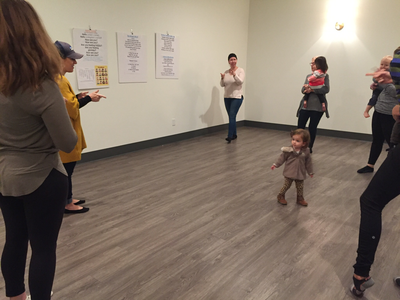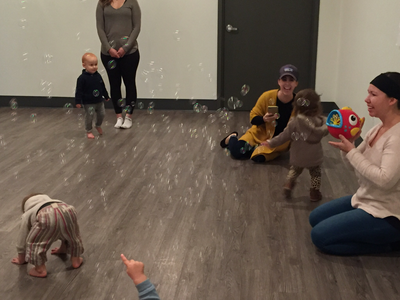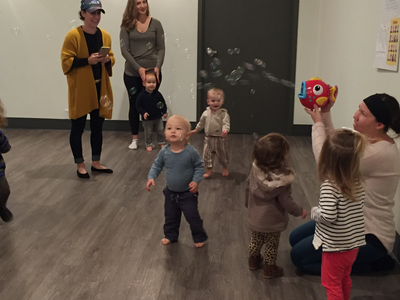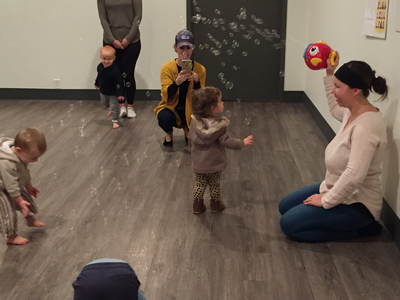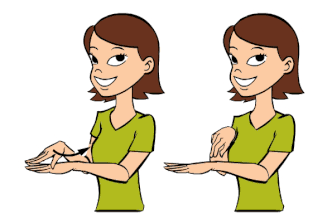Fun foundations class: STOP + GO
(sorry there's not that many pics from the GR class, or any from Holland! I couldn't take pictures because I was in charge of the bubble machine)
Stop + Go!
- It is REALLY important to work on comprehension of these language concepts before you're in an emergency situation (e.g. running into the street, toward a pool, toward an aggressive dog, etc.)
- We want to continue to use positive language (need a refresher on what that is? Check out this handout)
- Examples: "Stay here," "come here," "hold my hand/cart" -
- RATHER THAN "don't run away from me," "don't go in the road!", "no running"
- Stay consistent
- Be intentional about your timing
- Remember: if we tell our children the same thing (e.g. "come here") 15 times before actually following through on helping them follow the direction, they are learning to NOT listen to us
- Only say “stay here” when you can help them do it at first
- Don’t make a running away when you say "come here" a game - and don’t let others make it a game!
- Ugh! My father-in-law made this a game! He started chasing Callum and saying "come here! I'm gonna get you! Come here" and so now Callum runs away laughing EVERY TIME I say "come here." We have a LOT of work to do in this area!
- Give opportunities to practice
- Let your child get out of the cart or carrier in safe and practical situations
- Give choices
- Example: "Would you like to hold the cart/stroller or hold my hand?"
language strategies discussed in class
Translation: You guessed it - another indirect language facilitation strategy to add to your language-boosting toolbox! The reason I keep teaching you these is because THEY WORK! :)
Often times, particularly with toddlers, we get a little hung up on what a child is VERBALLY saying (or not saying) that we forget to look at how children are communicating with us in other ways. It is important for YOU, as a parent, to learn to watch your child for those times when he is communicating to you in other ways. Often times we are so busy watching for signs of speech, that we miss the many times our children are communicating to us - and what the message really is.
So here's how to interpret these communication messages so that we can eventually use them to help our children communicate more effectively!
Being a Translator: What it Means
We all know a translator or interpreter is someone who interprets or translates someone's messages to others. If we want to have a conversation with someone who doesn’t speak our native tongue, we need someone to translate our message to our communication partner. Now, it is time for you to start translating your child’s messages so that you can respond appropriately.
We have to listen with both our ears and OUR EYES to become awesome at translating. You are going to translate your child's message, based on your observations of your child’s ACTIONS, SOUNDS and VERBALIZATIONS. In other words: You are going to make an educated guess on what you think he is trying to communicate - and then verbally say what s/he WOULD say using a 1-4 word phrase, in first person language.
Being a Communication Detective: How to Interpret Your Child’s Message
Interpreting your child’s message takes a little bit of detective work sometimes. You have to watch and listen and sometimes use educated guesses to figure out what kind of message your child might be sending you. Here are the basic steps of interpreting your child:
What Does This Look Like?
Believe it or not, you’ve been interpreting your child’s messages from the day he was born, although you may not have always said them aloud to him. When he cried, you interpreted that to mean he needed to to eat, or needed a diaper change. When he smiled and laughed when you bounced him, you interpreted that to mean he liked the activity and wanted more.
Now that we are helping our children speak, we do the same exact thing, except we say out loud what our child might say in that moment. We want to use a 1-4 word phrase and use first person language (e.g. "I want.." not "you want..."). I've found it often helps for parents to preface this by saying, "You could say: ___________."
Here are some examples:
WHY practice Translation?
We want to model the phrases our child could be using to communicate their wants, needs and ideas.
We want to use first person language (I, me, my) to help them hear how those pronouns work in action.
Often times, particularly with toddlers, we get a little hung up on what a child is VERBALLY saying (or not saying) that we forget to look at how children are communicating with us in other ways. It is important for YOU, as a parent, to learn to watch your child for those times when he is communicating to you in other ways. Often times we are so busy watching for signs of speech, that we miss the many times our children are communicating to us - and what the message really is.
So here's how to interpret these communication messages so that we can eventually use them to help our children communicate more effectively!
Being a Translator: What it Means
We all know a translator or interpreter is someone who interprets or translates someone's messages to others. If we want to have a conversation with someone who doesn’t speak our native tongue, we need someone to translate our message to our communication partner. Now, it is time for you to start translating your child’s messages so that you can respond appropriately.
We have to listen with both our ears and OUR EYES to become awesome at translating. You are going to translate your child's message, based on your observations of your child’s ACTIONS, SOUNDS and VERBALIZATIONS. In other words: You are going to make an educated guess on what you think he is trying to communicate - and then verbally say what s/he WOULD say using a 1-4 word phrase, in first person language.
Being a Communication Detective: How to Interpret Your Child’s Message
Interpreting your child’s message takes a little bit of detective work sometimes. You have to watch and listen and sometimes use educated guesses to figure out what kind of message your child might be sending you. Here are the basic steps of interpreting your child:
- Sit back and quietly observe your child, listening with your eyes and your ears.
- Take note of what he is DOING. Is he….spending a long time playing with something? Smiling? Reaching out? Looking at you? Looking at something else? Turning away from something? Gesturing towards something? Pointing? What might these actions MEAN?
- Take note of what SOUNDS he is MAKING. Is he squealing? Laughing? Babbling? Do you hear infections in his babbling? What might these sounds MEAN?
- Take note of what WORDS (if any) he SAYING?
- Now, put all this together and use your detective skills and see if you can figure out what message he might be trying to send.
What Does This Look Like?
Believe it or not, you’ve been interpreting your child’s messages from the day he was born, although you may not have always said them aloud to him. When he cried, you interpreted that to mean he needed to to eat, or needed a diaper change. When he smiled and laughed when you bounced him, you interpreted that to mean he liked the activity and wanted more.
Now that we are helping our children speak, we do the same exact thing, except we say out loud what our child might say in that moment. We want to use a 1-4 word phrase and use first person language (e.g. "I want.." not "you want..."). I've found it often helps for parents to preface this by saying, "You could say: ___________."
Here are some examples:
- Scenario 1: Your toddler is playing with some toy cars. He reaches out towards a car near you, then looks at you, and then back at the car.
- Possible interpretation: It looks like your child wants the car.
- The caregiver could say in this scenario: “It looks like you want the car. You could say, 'Mom, I want car!'” then hand him the car.
- The caregiver could also simply say: "I want car!'” then hand him the car.
- Possible interpretation: It looks like your child wants the car.
- Scenario 2: You offer your child a banana and he pushes it away with his hand and turns his head away from you while squealing “ooooo”
- Possible interpretation:
- “No thank you! All done with banana.”
- Possible interpretation:
- Scenario 3: You are pushing your child in the swing and ask him “Do you want more swing?” He smiles and kicks his feet.
- Possible interpretation: “YES! I want more swing!” (If you had been ONLY focusing on his words, you may have missed him COMMUNICATING with his facial expression and foot movements!)
- Scenario 4: Your toddler is playing with playdoh and has been trying to flatten the dough with his hands. He looks around and says “Blue?”
- Possible interpretation: His questioning inflection makes you think he is asking something. Your first thought may be that he is asking for blue playdoh. But remember how he was trying to flatten the dough? Maybe he was actually asking for the roller, which is blue. This is why is is so important to listen with your eyes and not just your ears, because oftentimes, especially when there is little speech, a child’s nonverbal language is telling us so much more!
WHY practice Translation?
We want to model the phrases our child could be using to communicate their wants, needs and ideas.
We want to use first person language (I, me, my) to help them hear how those pronouns work in action.
sensory activities
|
Bubble Machine
Bubbles. Are. Magical. I'm not sure I could be a speech pathologist without bubbles. Ok, just kidding. They're not quite THAT magical - but they are amazingly motivating for kids. Pair bubbles, or even better, a bubble MACHINE, with signs + verbal words for STOP and GO, as well as MORE! They also support hand-eye coordination, pointing and joint attention skills! This is my favorite bubble machine of all time: Play Day Red Fish Bubble Machine (I found it for way cheaper at WalMart than Amazon). |
signs taught in class
Songs from STOP + GO class
|
|
"GO, SLOW, STOP"
**There's lots of options for this song:
LYRICS: (tune of Frere Jacques/Are You Sleeping) Green means “GO!” (x2) Go! Go! Go! (x2) (wave green scarf fast, run fast or sign GO) Yellow means “Slow.” (x2) Slow... slow... slow. (x2) (wave yellow scarf slowly, walk slowly or sign SLOW) Red means “STOP!” (x2) Stop! Stop! Stop! (stop waving scarf suddenly, stop moving or sign STOP) Go! Go! Go! (wave green scarf fast, run fast or sign GO) Slow... slow... slow. (wave yellow scarf slowly, walk slowly or sign SLOW) And Now Stop! (stop waving scarf suddenly, stop moving or sign STOP) |
|
|
LYRICS FOR "TWINKLE, TWINKLE TRAFFIC LIGHT"
Twinkle, twinkle traffic light Shining on the corner bright. Red means stop, green means go, Yellow means go but take it slow. Twinkle, twinkle traffic light Shining on the corner bright! |
|
|
LYRICS FOR "I HAVE A LITTLE BICYCLE"
I have a little bicycle (cycling motion with hands) I got it at the shop. And when a see that big red sign, I know it's time to STOP! (sign STOP) I have a little bicycle (cycling motion with hands) I ride it to and fro. And when I see a big green sign, I know it's time to GO, GO, GO! (sign GO) |
MOVEMENT SONGS FROM STOP + GO CLASS
|
|
LYRICS FOR "THE STOP SONG"
1. You walk (x6) and you stop! (repeat 3 times total) All to the beat of the music! 2. You stomp... 3. You run... |
|
|
LYRICS FOR "STOP: THE MAGIC WORD"
Chorus: This is a special song You have to put your ears on And listen for that magic word S.T.O.P says what you should do It’s something that you may have heard Verse 1: Stop, go, go, go Stop, go, go, go Stop, go, go, go - Stop! Repeat Chorus Verse 2: Run Repeat Chorus Verse 3: Crawl Repeat Chorus Verse 4: Dance Repeat Chorus Verse 5: Wave your hands Repeat Chorus Verse 6: Go |
bOokS FOR TALKING ABOUT STOP + GO
|
The book we read in class was Go, Dog, Go! by P.D. Eastman.
I seriously love ALL of the P.D. Eastman books as they target lots of great early language concepts, such as size words, prepositions and basic sentence structures, all using easy, repetitive language that helps kids learn to rhythm and prediction skills. |




